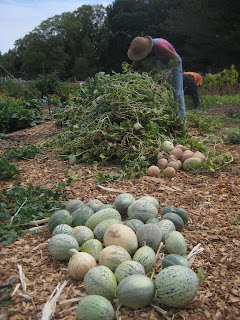Henry, the Indian Valley Organic Farm Supervisor. Those of us who enjoy the Farm owe a great deal of thanks to Henry and the conservation corps folks who work with him every day.
One of the benefits of my illustrious “compost waterer” job is that I visit the Indian Valley Organic Farm in the evening. Hikers are out late, enjoying these last days of Indian Summer. They stop and lean into the wire fence like children longing to join a playground game. “How has it grown up so fast?” some wonder out loud. Others murmur and nod to each other. Some just stare. If I am within earshot, they’ll ask me about how the farm has done so well, so quickly. Which brings me back to our ongoing conversation about food production.
A very small percentage of people in this country, somewhere between 2 and 5%, buy only organic food and approx 30% buy organic food occasionally . Most of us who do eat organic food still rely on conventional farmers for about 90% of what we eat (btw: there is a lot to discuss about the label "organic' which I will do in another blog). The point is, we are a country that has set ourselves up to depend deeply on large scale conventional fertilizer and pesticide-fueled sustenance. It is extremely difficult, nearly impossible really, for a small farm to prosper. It is extremely difficult for a small farm to get organic certification.
Why then, would we be so starry-eyed and hopeful out at Indian Valley Organic Farm? Aren't we just a boutique garden? Does the work we do even relate to the future of food production in this country?
Scientist and author Janine Benyus wrote a book called Biomimicry: Innovation Inspired By Nature. In an interview in the September issue of The Sun magazine she says this:
"Ecologists often speak of different stages of ecosystems. Say you take a field and plow it up completely. The first species to come in – called “type one” – are weeds. Our economy is what you might call a “weed field.” These small annual plants put all their energy into seeds and very little energy into roots, because next year those seeds are going to blow away and seed another field. Type-one species are pioneers, and we humans have been a pioneer species, going from open field to open field instead of learning how to live in one place, recycle everything, and develop symbiotic relationships…What comes in after those pioneers are perennials such as berry bushes. These Type-two plants put down roots and hook up with other plants. A Type-three ecosystem is a mature forest that will last for hundreds of years, or until the next big fire…the strategies of an organism in a mature forest are very different from the strategies of pioneering Type-One organisms…Now things have changed. We (humans) are a large population in a crowded world with limited resources. Our strategies have to shift. We have nowhere else to go.”
Benyus says it is time for us to “sit at the foot of nature” and “become students of a teacher who’s been here much longer than we have. There’s no time for untested technologies that may not be a fit for the earth. We’ve got to use technologies that have already been tested by nature herself.” (Here she is, a speaker for the TED series Janine Benyus Shares Nature's Designs )
Everyone in the class would have their own reasons for taking the Indian Valley Organic Farm class. My answer is about quality of life. Our efforts to dominate nature are failing us. Our current systems, designed by a radical free market, have created too many environmental problems. Decisions about eating, one of our most vital activities, rests in the hands of We-Don’t-Know-Who. It has gotten to the point that when we purchase food from a grocery store and prepare a meal, we harbor doubt, wondering Will this produce harm us more than it will help us? We are anxious and insecure about our food and how it is grown. This is no way to live. (It turns out that a couple of Nobel Prize winning economists are coming to the same conclusions....Gross Domestic Product is not necessarily the best way to measure the health and well-being of a nation Emphasis on Growth Is Called Misguided -- NY Times.)
Indian Valley Organic Farm shows those disbelieving passers-by who lean, wide-eyed, into the fence that Yes, it is possible to “sit at the feet of nature” and use the essential energy of the earth carefully, to grow food that leaves us nourished, without fear and doubt.
Reaching skyward
















































